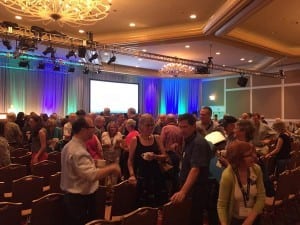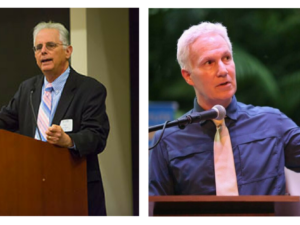How to give an engaging climate presentation
By Dana Couto
Effective communication skills are essential for climate advocates, especially those who give public presentations at events or to local community groups. Luckily, it’s a skill set not limited to the extroverted among us. In the Citizens’ Climate University (CCU) session called “A Fresh Approach to Engaging Presentations,” anyone can learn how to capture an audience’s attention about climate change and move them to action.
Watch the full lesson below, or read on for a quick recap:
Steve Levin, a leadership coach and organizational consultant who works with executives, offers his expertise in this training session. He encourages CCL volunteers to explain a little less and engage a little more in their presentations about climate change. By doing so, volunteers can transform the public in three pivotal ways:
- From vaguely aware of climate change…to urgently concerned.
- From waiting for a solution…to becoming part of the solution.
- From taking only personal action…to advocating for a national policy.
With these goals in mind, Steve walks through a sample presentation that CCU attendees can analyze, asking themselves: What is working? Why are these communication strategies effective?
Steve’s sample presentation
First, he establishes his own identity as a presenter as well as his purpose for speaking. He recommends striking a balance here: presenters must speak with enough authority to get the point across, but with enough humility to acknowledge that they do not have all the answers.
The flow and sequence of the presentation also matter—the audience should feel that the presenter is truly connecting and bonding with them. One strategy that Steve uses to do that is asking audience questions. After introducing the basics of climate science, Steve asks for a show of hands to tally people’s current knowledge of climate change. This gives the audience an opportunity to acknowledge gaps in their understanding and therefore areas for improvement. Watch how he does this:
Above all, Steve emphasizes “inspiration, not just information.” A presentation should remain focused on climate solutions—not just the problem of climate change itself. Presenters may refer to other webinars that individuals can watch, offer supplementary resources and support, and offer ways that the viewers can remain involved when the presentation ends to advocate for national policy at the local level.
Moving people to action
Again, the goal of giving an engaging presentation is to get your audience members to act on climate. What shifts people from being in a state of “wait and see” about climate change to a “do it now” position on climate solutions? Steve explains that it takes these four elements: personal conviction, a path to success, a playbook, and support. He then ties each of those to CCL. Watch him explain in this short clip:
Steve ends his presentation by offering supplemental contacts and his own personal information, so that those listening can reach out to him with questions or to get more information.
In 2018, CCL volunteers held more than 3,000 speaking or tabling events nationwide. As of right now, there are over 500 active CCL presenters. With this advice, those presenters can ensure their talks are even more effective and engaging.
CCL’s founder, Marshall Saunders, has said, “Preserving a livable world is up to us little people. What we do and do not do really counts.” In that spirit, consider giving a presentation in your community about climate solutions! You can join the Presenters Action Team, led by Dave Cain, for support. Sign up for the team to connect with others on CCL Community by clicking on “Presenters and Schedulers.”
Every week, Citizens’ Climate University hosts a live, online learning session to educate and empower climate action volunteers. Browse past lessons and upcoming topics in CCL Community.
Dana Couto is CCL volunteer, an undergraduate student at New York University, and is applying to law school to become an environmental lawyer.






